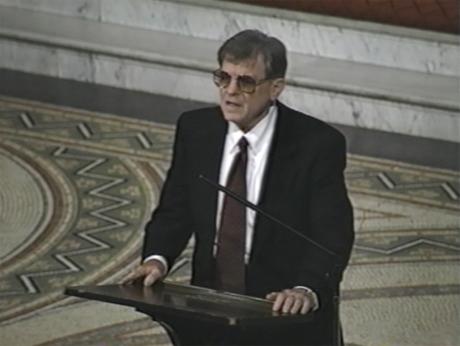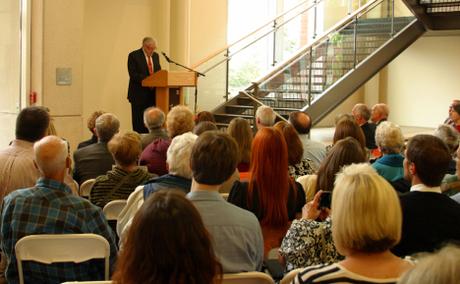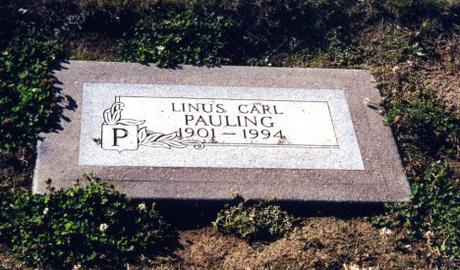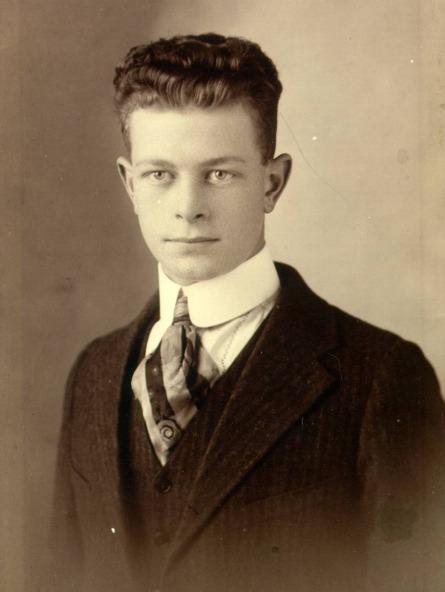
Linus Pauling Jr. speaking at his father’s memorial service, August 29, 1994.
[Part 4 of 4]
On August 29th, 1994, a memorial service planned by Pauling’s children and his long-time assistant Dorothy Munro was held at Memorial Church on the campus of Stanford University. Many people spoke, including Linus Pauling Institute of Science and Medicine administrator Steve Lawson, Oregon State University president John Byrne, and scientific colleagues Frank Catchpool and Verner Schomaker.
Remembrances were likewise offered by close friends and family. Pauling’s youngest son Crellin spoke movingly, while also offering comments written by his brother Peter, who was living in Wales at the time and was unable to travel to attend the memorial. Pauling’s daughter Linda, and eldest son Linus Jr., also gave their heartfelt goodbyes to their father. Steve Rawlings, the ranch hand who had cared for Pauling for the past several years, spoke of the bond that they had formed. Four of Pauling’s grandchildren – Cheryl and David Pauling, and Barky and Sasha Kamb – recalled fond memories of their Grandpa.
The memorial program featured a quote to remember Pauling by, one taken from his 1958 book, No More War. It read:
Science is the search for truth- it is not a game in which one tries to beat his opponent, to do harm to others. We need to have the spirit of science in international affairs, to make the conduct of international affairs the effort to find the right solution, the just solution of international problems, not the effort by each nation to get the better of other nations, to do harm to them when it is possible. I believe in morality, in justice, in humanitarianism.

Linus Pauling Jr. speaking at the grand opening of the Linus Pauling Science Center, October 19, 2011.
With its director of research and namesake now gone, the reigns at LPISM were taken up by Linus Pauling Jr. In so doing, Linus Jr. sought mainly to secure his father’s long-term legacy by moving his beloved but financially unstable institute from its location in Palo Alto, and to associate it with a prestigious academic institution, where it might find new and greater successes.
Along with Lawson and the Institute’s Board of Trustees, Linus Jr. entered into conversations with a number of universities where they believed that LPISM’s orthomolecular mission might find support. At the same time, the Institute benefited greatly from a large number of memorial donations and bequests made in honor of Pauling. Ultimately, an agreement was struck between the Institute and Oregon State University, which offered to match those contributions.
This resulting endowment in hand, a new director, Balz Frei, was brought on board and, at its new home in Corvallis, the Linus Pauling Institute was reborn. While still able to engage in the orthomolecular research that Pauling had always envisioned, the move to OSU offered the Institute the opportunity to open up new lines of research in other areas of human health. When Linus Jr. gave the keynote address at the grand opening of OSU’s brand new Linus Pauling Science Center in 2011, he spoke of this evolution.
I’ve appreciated other people’s recognition of (my father’s) capabilities and endeavors, and done what I can to increase that appreciation and recognition. My whole investment in LPI was part of that too, recognizing my father’s contribution to society…and wanting to make sure in some way that he didn’t get lost in the sands of time. What has happened has pleased me. I don’t think there’s anything I can do to personally do more than I have done. I don’t think I’m going to try… I’m very appreciative of those who have dedicated themselves to the continuation of my father’s reputation. I feel that I can rest assured that he will not be forgotten.

Linus Pauling’s humble marker at the Oswego Pioneer Cemetery, as photographed in 2009.
Before he died, Pauling made clear his wish to be cremated and to have his ashes, along with those of his wife, interred in Lake Oswego, Oregon at the Pioneer Cemetery where his parents were buried. In 1994, a cenotaph – which is a marker honoring a person whose remains are elsewhere – was placed in the family plot by Pauling’s sister, Pauline. Pauling’s ashes remained with Ava Helen’s among family in California until 2005, when they were finally moved to Oregon and placed alongside those of Pauling’s parents, Herman and Belle.
In 2013, an Oregon resident named Jean Crellin Ashby took her mother to see Linus Pauling’s grave at Pioneer Cemetery. Ashby is the granddaughter of Edward Webster Crellin, a mentor and colleague of Linus Pauling’s at Caltech, and the man after whom Pauling named his youngest son. Standing over Pauling’s marker, Ashby thought about how her grandparents were buried in Pasadena. Since she was unable to easily visit their graves, given the considerable distance, Ashby decided that honoring Pauling’s family in Lake Oswego would also serve to honor her own. Subsequently, Ashby contacted cemetery administrators and filed the appropriate paperwork to become the official caretaker for the Pauling plot, which she and her family still maintain today.
It is Pauling’s legacy that we honor on this, the twenty-second anniversary of his passing. And what better way to reflect on that legacy than to return to the diary entry that Pauling wrote when he began the history of his life at the age of 16. In it, Pauling said that his history was not intended to be merely a life’s story. Rather, it was to be a reflection on good times had in his passage through this “vale of tears”
Often, I hope, I shall glance over what I have written before, and ponder and meditate on the mistakes that I have made—on the good luck that I have had—on the carefree joy of my younger days; and pondering, I shall resolve to remedy my mistakes, to bring back my good luck, and to regain my happiness.

